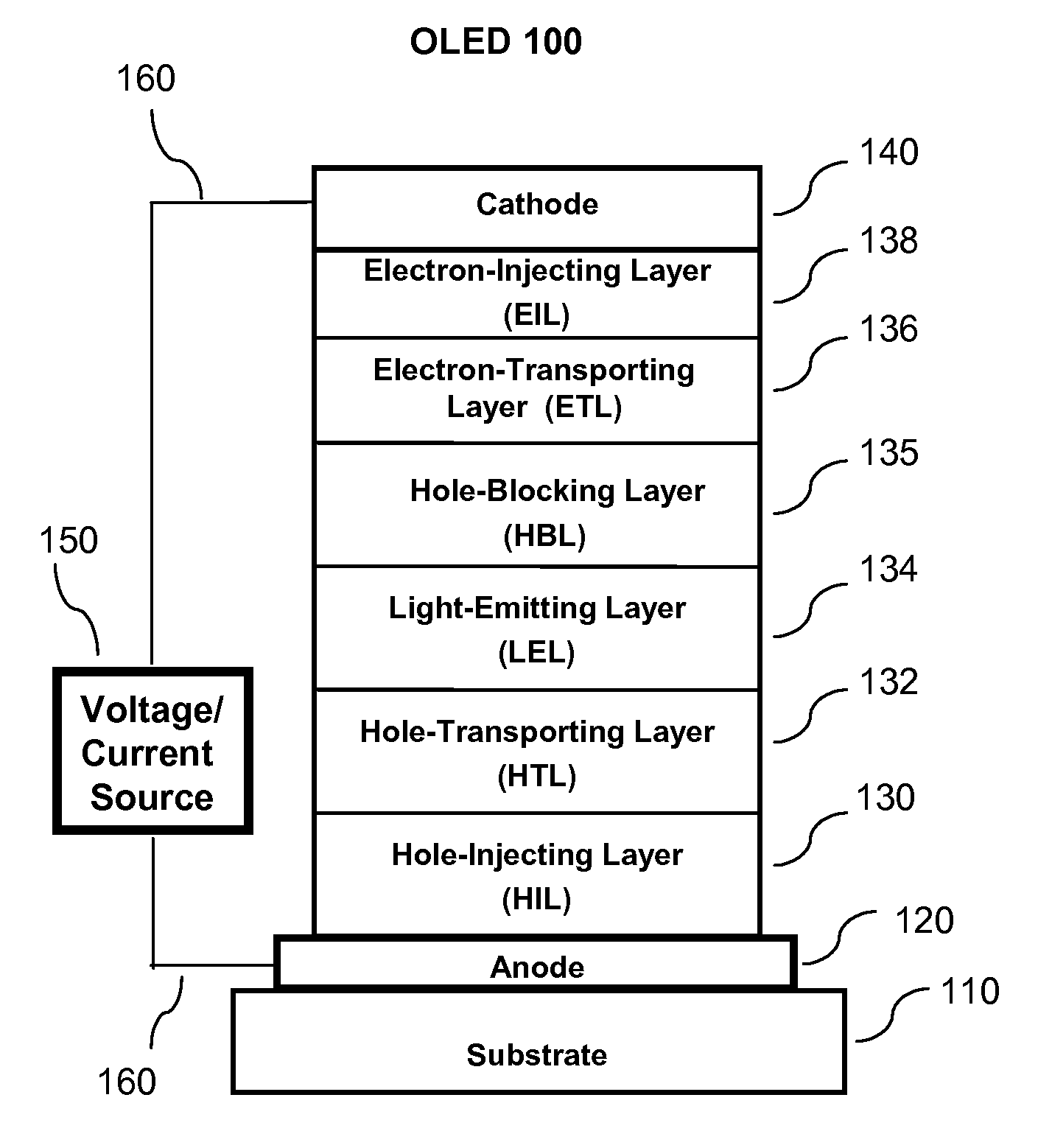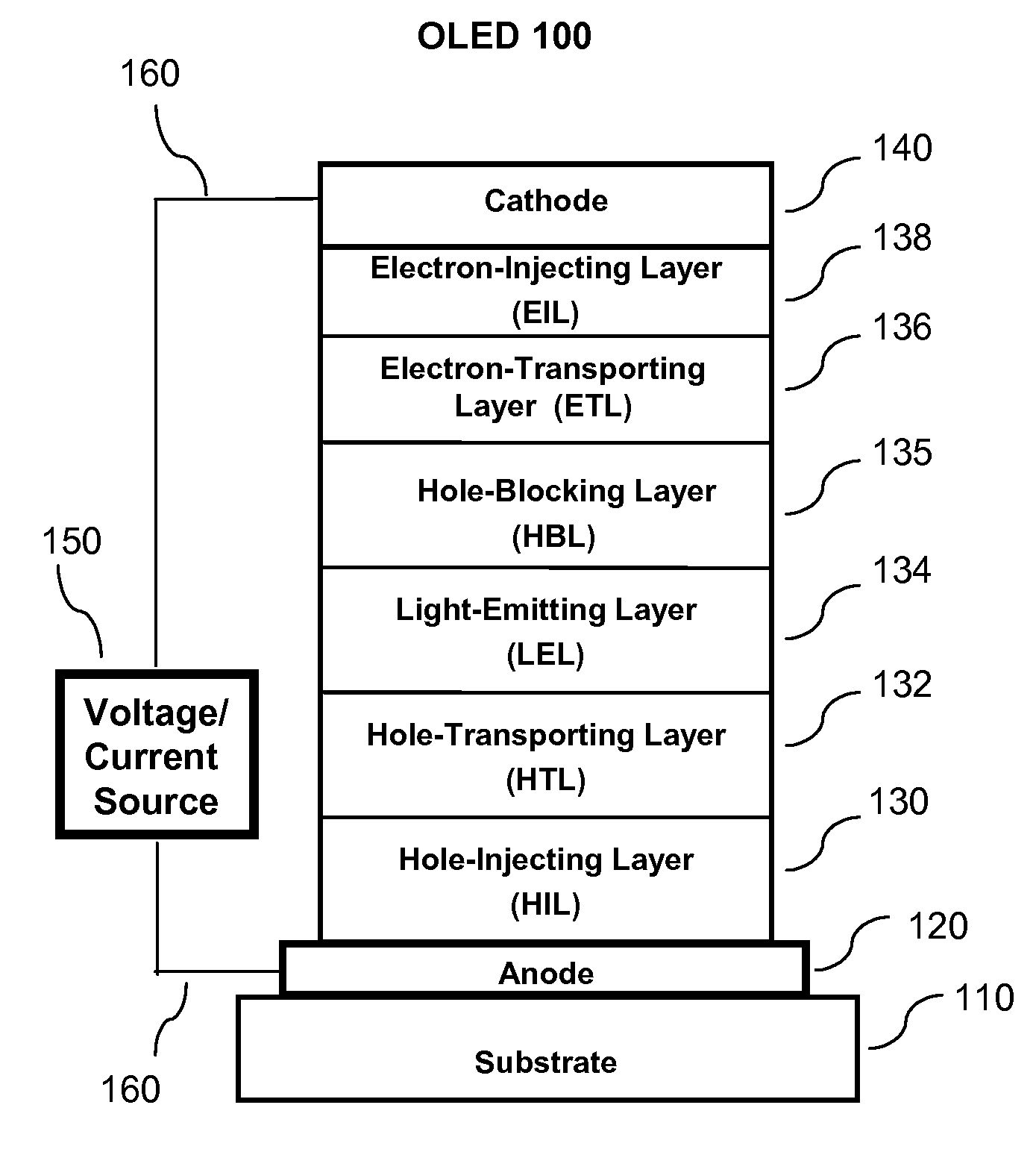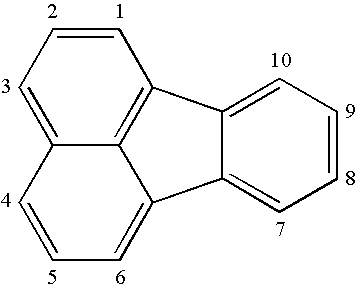OLED device containing a silyl-fluoranthene derivative
a technology of fluoranthene derivative and oled, which is applied in the direction of discharge tube luminescnet screens, discharge tube/lamp details, electric discharge lamps, etc., can solve the problems of performance limitations that have been a barrier to many desirable applications, and achieve the effect of improving efficiency and drive voltag
- Summary
- Abstract
- Description
- Claims
- Application Information
AI Technical Summary
Benefits of technology
Problems solved by technology
Method used
Image
Examples
example 1
Synthesis of Inventive Compound Inv-3
[0345]Inv-3 was synthesized as outlined in Scheme 1 and described below.
Preparation of Compound (1)
[0346]7,9-Diphenyl-8H-Cyclopent[a]acenaphthylen-8-one, (Acecyclone, (1)) was prepared according to the procedure of W. Dilthey, I. ter Horst and W. Schommer; Journal fuer Praktische Chemie (Leipzig), 143, (1935), 189-210.
Preparation of Inv-3
[0347]Acecyclone (3.7g, 10 mMoles) and (dimethylphenylsilyl)acetylene (5.0g, 31 mMoles) were heated in 1,2-dichlorobenzene (80 mL) at 200° C. for 12 hours. The solution was then cooled and methanol was added (approximately 30 mL) to induce cloudiness. On continued stirring at room temperature, the product precipitated. The faintly yellow solid was washed with methanol and air dried to afford 3 g of product. The product was sublimed at 200° C. / 3×10−1 Torr, mp 175° C. to afford 8-dimethylphenylsilyl-7,10-diphenylfluoranthene (Inv-3). Analysis of the 1H NMR spectrum and the mass spectrum (MS) indicated that the des...
example 2
Electrochemical Redox Potentials and Estimated Energy Levels
[0348]LUMO and HOMO values are typically estimated experimentally by electrochemical methods. The following method illustrates a useful way to measure redox properties. A Model CH1660 electrochemical analyzer (CH Instruments, Inc., Austin, Tex.) was employed to carry out the electrochemical measurements. Cyclic voltammetry (CV) and Osteryoung square-wave voltammetry (SWV) were used to characterize the redox properties of the compounds of interest. A glassy carbon (GC) disk electrode (A=0.071 cm2) was used as working electrode. The GC electrode was polished with 0.05 μm alumina slurry, followed by sonication cleaning in Milli-Q deionized water twice, and rinsed with acetone in between water cleaning. The electrode was finally cleaned and activated by electrochemical treatment prior to use. A platinum wire served as counter electrode and a saturated calomel electrode (SCE) was used as a quasi-reference electrode to complete a...
example 3
Preparation of Blue-Light Emitting OLED Devices 3.1 through 3.11
[0351]A series of OLED devices (3.1 through 3.5) were constructed in the following manner:[0352]1. A glass substrate coated with an 85 nm layer of indium-tin oxide (ITO), as the anode, was sequentially ultrasonicated in a commercial detergent, rinsed in deionized water and exposed to oxygen plasma for about 1 min.[0353]2. Over the ITO was deposited a 1 nm fluorocarbon (CFx) hole-injecting layer (HIL) by plasma-assisted deposition of CHF3 as described in U.S. Pat. No. 6,208,075.[0354]3. Next a layer of hole-transporting material 4,4′-Bis[N-(1-naphthyl)-N-phenylamino]biphenyl (NPB) was deposited to a thickness of 95 nm.[0355]4. A 20 nm light-emitting layer (LEL) corresponding to host material P-4 and 1.5% by volume of dopant FD-54 was then deposited.[0356]5. A 35.0 nm electron-transporting layer (ETL) containing a first electron-transporting material (ETM 1) corresponding to Inv-1, or a second-electron-transporting materi...
PUM
 Login to View More
Login to View More Abstract
Description
Claims
Application Information
 Login to View More
Login to View More - R&D
- Intellectual Property
- Life Sciences
- Materials
- Tech Scout
- Unparalleled Data Quality
- Higher Quality Content
- 60% Fewer Hallucinations
Browse by: Latest US Patents, China's latest patents, Technical Efficacy Thesaurus, Application Domain, Technology Topic, Popular Technical Reports.
© 2025 PatSnap. All rights reserved.Legal|Privacy policy|Modern Slavery Act Transparency Statement|Sitemap|About US| Contact US: help@patsnap.com



